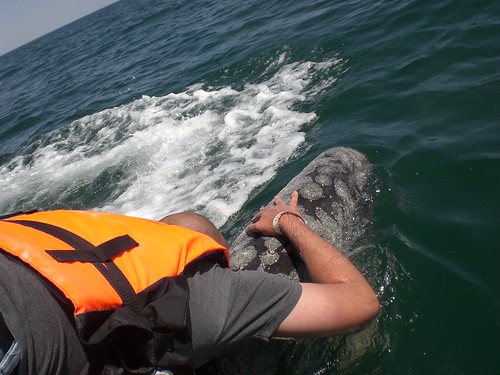 A nearby boat run by National Geographic came to the rescue, but was the situation made worse because the cruise ship ran out of pre-paid satellite phone minutes?
Keep reading Was the Antarctic tour boat rescue slowed by running out of pre-paid sat phone minutes?
 Across the southwest is a cartoonish squirrel that wears a gray tuxedo and tassles on his ears. You can call them either Abert or Abert’s Squirrel.
Keep reading Abert’s Squirrel: Cartoonish and Likes Western Mountains
 The United States and the Fish and Wildlife Service just announced it was going to stall another year before coming up with a plan to save the jaguar.
Keep reading Is the Jaguar the next “experimental, non-essential” endangered species?
 Happy World Animal Day and World Farm Animal Day. Around the world, in places you didn’t even think cared about animals, people will demonstrate; party; preach; walk; collect money, food and toys for animals.
Keep reading Animals Have a Busy Weekend Coming Up
 My personal opinion is, what’s the harm of trying? It could be a total disaster if the oil spill continues and spreads. Why not spend some money to keep these turtles out of the way?
Keep reading Help Stop Sending Kemp’s Ridley Turtle Hatchlings Into the Gulf Oil Spill

A jaguar has been confirmed living–or at least roaming–within 30 miles of the U.S. border with Mexico. The Cougar Network, which tracks big cat sightings, sent out word that the Sky Island Alliance has two photos of jaguars eight days apart about 90 miles north of where everyone thought they lived in Sonora.
Conservation groups like the Northern Jaguar Project, have worked for years to bring back the big, spotted cat that once ranged as far north as the Grand Canyon across California, Arizona, New Mexico, Texas, and possibly Louisiana.
The find would be significant because last year the last known U.S. jaguar died under circumstances that increasingly look dodgy. Arizona Fish and Game caught Macho B in a trap they said was for bears or cougars. They tranquilized and collared him. Days later the then-sluggish cat was euthanized. The capture and drugs may have hastened his death. Just last month investigators found that the capture was intentional, a possible felony since the jaguar (Panthera onca) is endangered.
Just last month the Fish and Wildlife service reversed a 2006 decision and determined that the jaguar deserves a critical habitat. Even the known population in the Northern Jaguar Preserve, 135 miles south of the border, is cut off by hundreds of miles from the the main population.
The motion-activated game cameras showed the jaguars from different sides, so no one is sure if it’s the same cat, Sergio Avila, an alliance biologist in Tucson, told the Arizona Daily
Keep reading Jaguars, Extinct in US, Found Within 30 Miles of Border
 The Bahamas are down to only six wild horses. Genetic tests show they’re Spanish Barbs who improbably survived for generations in pine forest and scrub.
Then logging companies came–clearing forests, bringing hunting dogs and flushing the horses into view, according to Equiworld.net. “The road put in by the logging company opened the area up to local hunters. When a child died due to her own misbehavior with a horse, locals tried to slaughter all the horses. Three were rescued and placed on the [Bahamas Star Farms] and as their numbers grew they were released back into the regenerating forest,” say Milanne Rehor who founded Wild Horses of Abaco. Rehor desrcribes herself as a once “horse crazy child,” set out to find them after reading of them in a sailing guide. She eventually found that they were real, but about to disappear. In 1982 there were 35 Abaco horses. In 2005, the Bahaman government claims it shut down Bahamas Star Farms because of a citrus canker; Rehor says the area was clear cut. Now a mysterious illness is killing off the horses. “It has been invaded by Brazilian pepper and Lantana Sage, the latter deadly to animals. The horses know to not eat it, but it became so thick in one forage area that two ingested it by accident and died,” Rehor says. “The area has been closed off and there have been no more loses.”
Here’s the group’s emergency plan. If this rare population is going to survive, they
Keep reading The Last Wild Horses in the Bahamas
 Photo of man hugging gray whale in San Ignacio Bay courtesy of Marc Uhlig of Jupiter Labs. Biologist Toni Frohoff has a new way see whales and other wildlife: collaborative watching. That’s right: she wants us to work with whales so we all get something out of the experience. Instead of just being stalkers, we’d interact on mutually agreeable terms. What Frohoff, research director at TerraMar Research and the Trans-Species Institute of Learning, is proposing is an overhaul of eco-tourism standards. She wants the whales (and other animals) to be in on it, to collaborate with the humans that want to watch them.Sound impossible? Well, she does it all the time with gray whales in Baja California. As a behavioral biologist she made an appearance in the much-discussed New York Times Magazine story Watching Whales Watching Us. The gray whales migrate up and down the west coast, seemingly indifferent to humans, but once they reach their nursery harbors off Baja, they suddenly become curious about people. That’s even more remarkable since people once slaughtered whales here–so much so the species was almost wiped out. But now they’ve realized people–or at least the people in these harbors–aren’t throwing harpoons, they are offering hugs.
Photo of whale near row boat courtesy of FarFlungPhotos and Tarnya Hall.What do the whales get out of it? For reasons no one can explain, they seem really into it, coming up to boats curiously and seeking out interaction, not just tolerating it.
What the whales can
Keep reading What is Collaborative Whale-Watching and Wildlife Viewing?
|
Subscribe SUBSCRIBE TO THE BLOG

|









Recent Comments